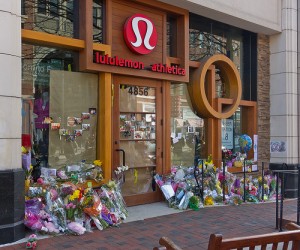Race, Class and Lululemon

Flickr: ehpien
Pictures, flowers and stuffed animals surround the entrance to the Bethesda outpost of Lululemon, after Jayna Murray's murder.
Over at The Root, Latoya Peterson explores the race and class angles of the Lululemon case, which was initially thought to be a double rape and murder. Jayna Murray and Brittany Norwood returned to the upscale yoga store in Bethesda after hours; when a coworker showed up to open the store the next day, Murray was dead and Norwood was bound.
Norwood told police that two men had raped both her and Murray and then killed her coworker. That story unraveled as police investigated the case. Now, Norwood, who is black, is accused of killing Murray, who was white over a dispute involving potentially stolen merchandise. There was no sexual assault. Here’s Peterson on the media coverage:
Interestingly, though, both class and race had an indirect hand in why this story made national headlines. Slate touches on this: “The media does its part, of course. Murders don’t typically make headline news, unless there’s something unusual about them — for example, that they occur in an upper-middle-class suburb. (Slate’s Timothy Noah calls this genre of news coverage ‘When Bad Things Happen to White People.’)”
Over and over again, media reports played up the fact that violent crime was an anomaly in Bethesda. And it’s true — the suburb, located in one of the country’s wealthiest counties, has a lower rate of both property and violent crime than the surrounding areas and many other areas in the nation.
But what makes this crime more impressive to the media gaze? Initial reports circumvented the normal “missing/dead white girl” angle by publishing pictures only of Norwood, the assumed sole survivor, with relatively few images of Murray to be found. So class was a primary motivator for the initial reporting, and why the story got so much coverage.





